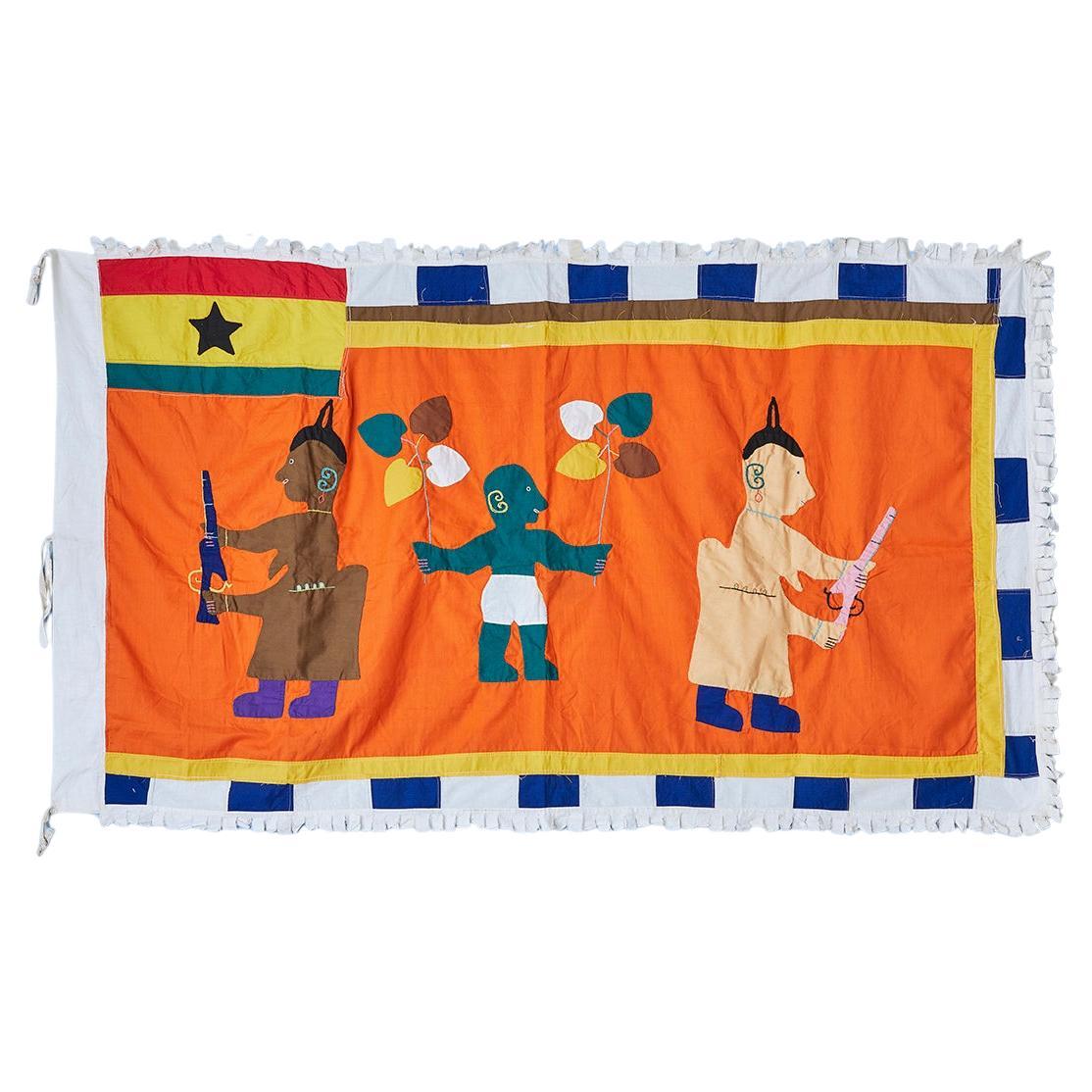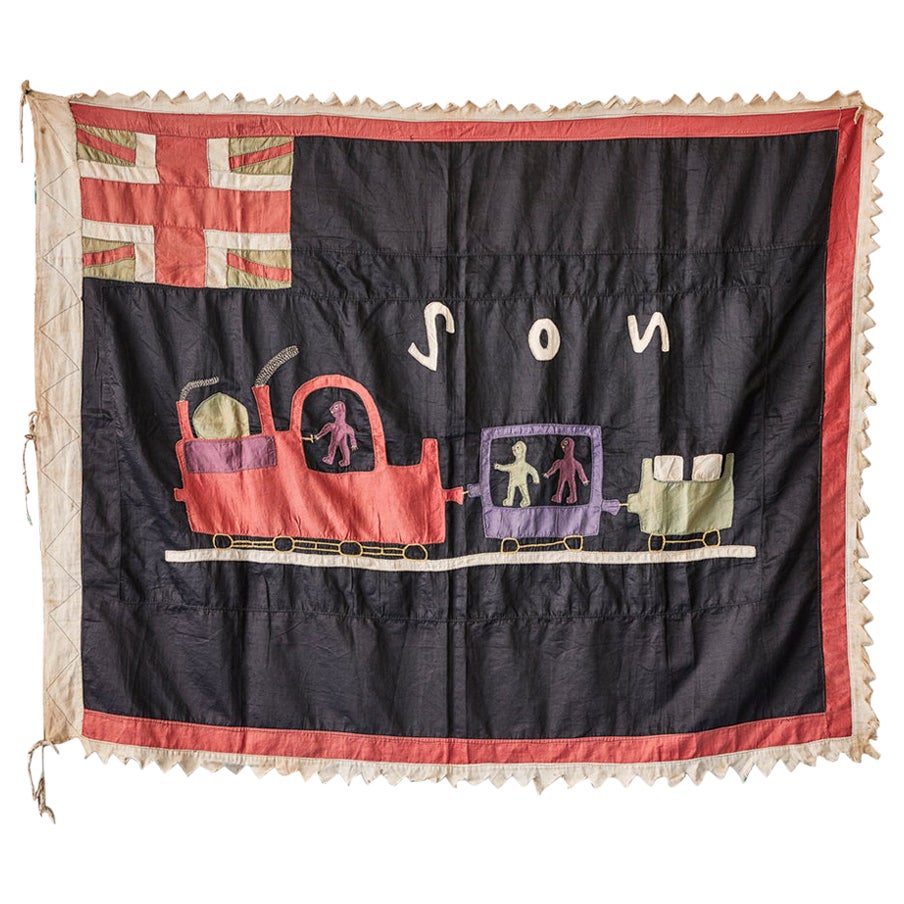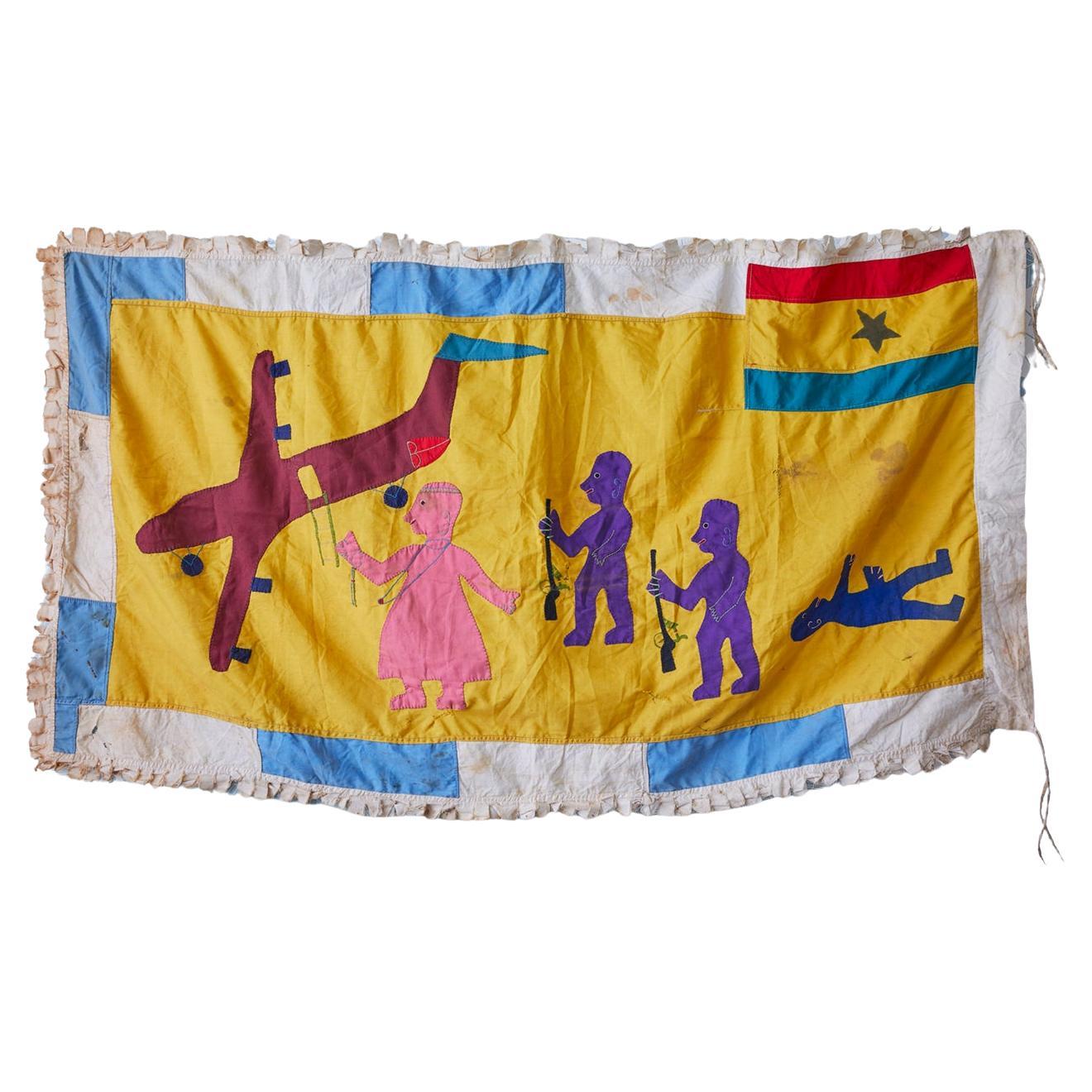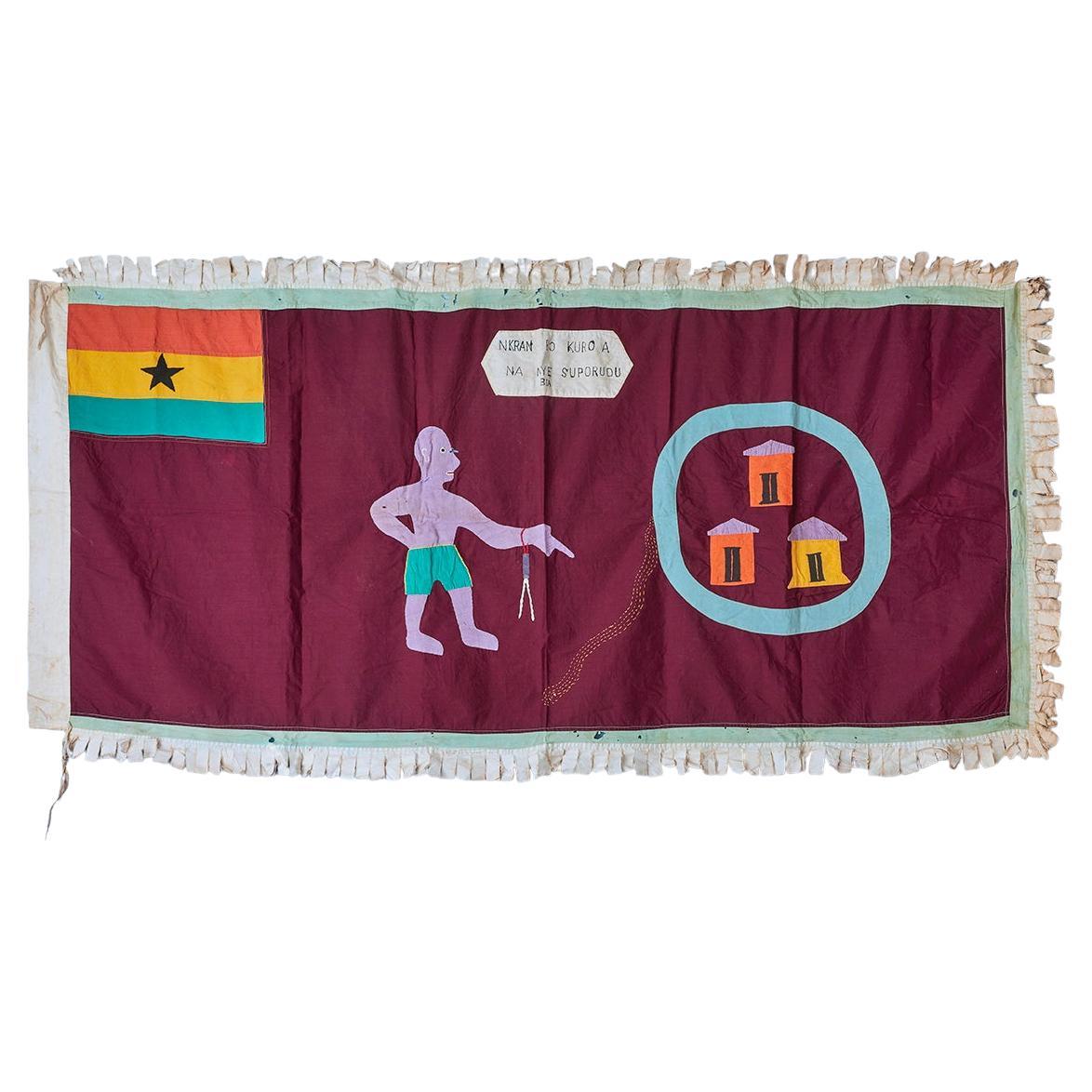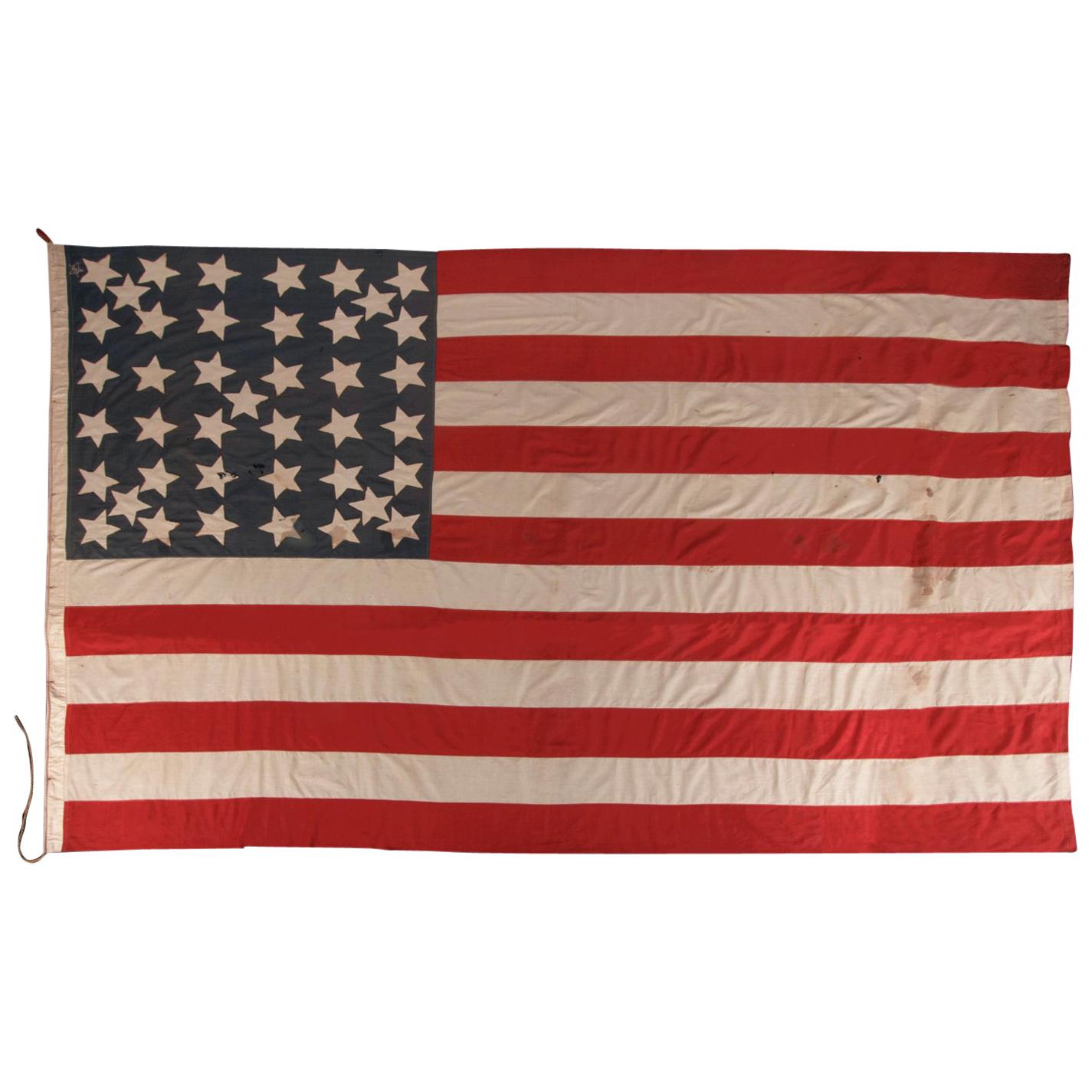Items Similar to Vintage Kwamina Amoaku Asafo Flag in Cotton Appliqué Pattern, Ghana, 1960s
Want more images or videos?
Request additional images or videos from the seller
1 of 10
Vintage Kwamina Amoaku Asafo Flag in Cotton Appliqué Pattern, Ghana, 1960s
About the Item
Kwamina Amoaku
Ghana, 1960's
Fante Asafo flag in cotton applique patterns. Fante People.
Asafo Flags are created by the Fante people of Ghana. The flags are visual representations of military organisations in Fante communities known as “Asafo”. The communities each have their own flag, name and number. The primary role of the “Asafo” and their flags was to exert power, political influence and maintain codes of conduct within Fante communities.
H 103 x W 157 cm
- Dimensions:Height: 40.56 in (103 cm)Width: 61.82 in (157 cm)Depth: 0.2 in (5 mm)
- Style:Folk Art (Of the Period)
- Materials and Techniques:Cotton,Appliqué
- Place of Origin:
- Period:
- Date of Manufacture:1960s
- Condition:Wear consistent with age and use.
- Seller Location:Copenhagen K, DK
- Reference Number:1stDibs: LU1011235050592

About the Seller
4.6
Vetted Seller
These experienced sellers undergo a comprehensive evaluation by our team of in-house experts.
Established in 2011
1stDibs seller since 2013
193 sales on 1stDibs
Typical response time: 2 hours
- ShippingRetrieving quote...Ships From: Copenhagen K, Denmark
- Return PolicyThis item cannot be returned.
More From This SellerView All
- Vintage Asafo Flag in Pink Cotton Appliqué Pattern by Fante People, Ghana, 1960sBy Fante PeopleLocated in Copenhagen K, DKKwamina Amoaku Ghana, 1960s Asafo flag in cotton applique patterns. Fante People. Asafo Flags are created by the Fante people of Ghana. The flags are visual representations of mili...Category
Vintage 1960s Ghanaian Folk Art Political and Patriotic Memorabilia
MaterialsCotton
- Vintage Fante People Asafo Flag in Orange Cotton Appliqué Patterns, Ghana, 1970sBy Fante PeopleLocated in Copenhagen K, DKGhana, 1970s Asafo flag in cotton applique patterns. Fante People. Asafo Flags are created by the Fante people of Ghana. The flags are visual representations of military organisat...Category
Vintage 1970s Ghanaian Political and Patriotic Memorabilia
MaterialsCotton
- Vintage Fante People Asafo Flag in Cotton Applique Patterns, Ghana, 1930-1950sBy Fante PeopleLocated in Copenhagen K, DKGhana, 1930s-1950s Asafo flag “The train is always ready to go” in cotton applique patters. Trains were a dramatic expression of power, regularity and reliability and as such were ...Category
Mid-20th Century Ghanaian Political and Patriotic Memorabilia
MaterialsCotton
- Vintage Fante People Asafo Flag in Yellow Cotton Appliqué Patterns, Ghana, 1980sLocated in Copenhagen K, DKGhana, 1980's Asafo flag in cotton applique patterns. Fante People. Asafo Flags are created by the Fante people of Ghana. The flags are visual representations of military organisat...Category
Vintage 1980s Ghanaian Folk Art Tribal Art
MaterialsCotton
- Vintage Asafo Flag in Burgundy Appliqué Patterns by Fante People, Ghana, 1960sBy Fante PeopleLocated in Copenhagen K, DKGhana, 1960's Asafo flag in cotton applique patters. Fante People. Asafo Flags are created by the Fante people of Ghana. The flags are visual representations of military organisati...Category
Vintage 1960s Ghanaian More Folk Art
MaterialsCotton
- Vintage Bamboo Coat Hanger, Italy, 1960sLocated in Copenhagen K, DKItaly, 1960s Large Bamboo coat hanger. Measures: H 105 x W 90 x D 10 cm.Category
Vintage 1960s Italian Hat Racks and Stands
MaterialsBamboo
You May Also Like
- 41 Stars In a Lineal Pattern With Offset Stars, Montana Statehood American FlagLocated in York County, PA41 STARS IN A LINEAL PATTERN WITH OFFSET STARS THAT CREATE A CROSSHATCH IN THE CORNERS AND CENTER, ONE OF THE RAREST STAR COUNTS AMONG SURVIVING FLAGS OF THE 19TH CENTURY, REFLECTS MONTANA STATEHOOD IN NOVEMBER, 1889, ACCURATE FOR JUST 3 DAYS: Numerous flags appeared with unofficial star counts in early America, produced by flag-makers in anticipation of the addition of more states. The 41 star flag...Category
Antique 1880s American Political and Patriotic Memorabilia
MaterialsCotton
- 38 Star American Flag, Stars in Notched Pattern, ca 1876-1889Located in York County, PA38 HAND-SEWN STARS IN A "NOTCHED" PATTERN, ON AN ANTIQUE AMERICAN FLAG WITH BEAUTIFUL WEAR FROM HAVING BEEN EXTENSIVELY FLOWN, MADE AT THE TIME WHEN COLORADO WAS THE MOST RECENT STATE TO JOIN THE UNION, 1876-1889 38 star Antique American flag, made during the period when Colorado was the most recent state to join the Union. The stars are arranged in what is known as a "notched" pattern, in which two spaces were left open along the hoist end, in the first and last rows, in anticipation that two more Western Territories would soon join the Union. The latter 19th century was a time of when much of the land in and about the Continental Divide was formalized into states, and there was continual speculation about which ones would be accepted next, and with what boundaries. The stars of the flag are made of cotton and are double-appliquéd (applied to both sides) with a lineal, treadle stitch. The canton and stripes of the flag are made of wool bunting that has been pieced with treadle stitching. The canton was constructed from five separate lengths of fabric, which is an unusual feature, though hardly unknown. To each of these a row of stars was sewn. This manner of construction is sometimes encountered and tends to be an early trait, at least when it occurs in flags of this scale and smaller. When encountered, it also seems to have been preferred in flags meant for maritime use. While the feature does not by any means guarantee this fact, it is a reasonable, educated guess, based upon my examination of many other examples. A flag with a 5-piece canton, such as this, would have been less likelihood to stretch, with increased structural integrity. The alternative is that this was simply an example made when there were at least five pieces of leftover fabric, of a reasonable size to made individual rows, and that what it actually demonstrates is the careful conservation of scarce resources. There is a sailcloth canvas binding along the hoist, with 3 brass grommets, evenly spaced. Perhaps the best feature of the flag is the evidence it displays of having been extensively flown, with the fly end whipped out from wind exposure. While many flags display damage from a combination of having been flown, exposure to the elements, various mishaps, and improper storage, very few exhibit wear such as this, which is both endearingly and visually attractive. This one shows its age beautifully, whipped out along the fly end, with losses that convey an element of movement, that most flags don’t capture in the state in which they survive. Colorado became the 38th state on August 1st, 1876. This was the year of our nation’s 100-year anniversary of independence. Per the Third Flag Act of 1818, stars were not officially added until the 4th of July following a state's addition. For this reason, 37 was the official star count for the American flag in 1876. Flag-making was a competitive venture, however, and few flag-makers would have been continuing to produce 37 star flags, when their competitors were making 38’s. It is for this reason that 38 and 13 stars (to represent the original 13 colonies...Category
Antique Late 19th Century American Political and Patriotic Memorabilia
MaterialsWool
- 38 Star Antique Flag, Stars in Double Wreath Pattern, Colorado Statehood 1876-89Located in York County, PA38 STAR ANTIQUE AMERICAN FLAG WITH A DOUBLE-WREATH CONFIGURATION THAT FEATURES AN ENORMOUS CENTER STAR, REFLECTS THE PERIOD OF COLORADO STATEHOOD, 1876-1889: 38 star American national flag, made entirely of plain weave cotton. The stars are arranged in a medallion configuration. This features an enormous center star, surrounded by two wreaths of much smaller stars, with a flanking star in each corner of the blue canton. The sort of disparity here, present in the scale of the large star, versus those around it, is both exceptionally unusual and graphically dynamic. Colorado became the 38th state on August 1st, 1876. This was the year of our nation’s centennial. Per the Third Flag Act of 1818, stars were not officially added until the 4th of July following a state's addition. For this reason, 37 remained the official star count for the American flag until part way through the following year. Flag-making was a competitive venture, however, and few flag-makers would have continued to produce 37 star flags when their competitors were making 38’s. Many flag-makers added a 38th star before Colorado entered the Union, in the early part of 1876, or possibly even prior. In fact, many makers of printed flags, called parade flags or hand-wavers, were actually producing flags in the 39 star count, in hopeful anticipation of the addition of two more Western Territories instead of one. It is for these reasons that 38, 39, and 13 stars, to representing the original 13 colonies, are most often seen on flags displayed at the Centennial International Exhibition. Hosted in Philadelphia, this enormous event was our nation’s first World’s Fair, lasted for a duration of six months, and served as the nucleus of celebrations held to honor America’s 100-year anniversary of independence. The 38 star flag became official on July 4th, 1877 and was generally used until the 39th state was added in November of 1889. This is probably a homemade flag, though sewn by a very skilled hand, or possibly, by two different individuals. The stripes are pieced and sewn entirely by hand, with remarkable care and precision. The canton is constructed of two lengths of blue fabric, that have been joined with treadle stitching. This was joined to the striped field by hand. The stars are double-appliquéd (applied to both sides) with treadle stitching. There is a treadle-sewn, cotton binding along the hoist, with five, hand-sewn grommets. It is extremely unusual to encounter this combination of sewing methods. Soon after the sewing machine was mass-marketed, in the mid-1850’s, flag-makers both public and private made good use of treadle machines, to join stripes, when constructing American flags. During the Civil War (1861-65), most stripes were treadle-sewn. Stars were another matter. Until the advent of electric machines...Category
Antique Late 19th Century American Political and Patriotic Memorabilia
MaterialsCotton
- 20th Century Fante Asafo Flag, GhanaLocated in New York, NYA large and graphically stunning Fante asafo flag. Fante flags represent the merger of two cultural traditions, the Akan tradition of combining pro...Category
Mid-20th Century Ghanaian Decorative Art
MaterialsFabric
- Mounted Asafo Flag of Ghana c.1820-1920Located in San Francisco, CAABOUT Contact us for more shipping quotes: S16 Home San Francisco. An original Asafo flag depicting the Fante people of Ghana, Africa and the Union Jack of the United Kingdom. Mou...Category
Antique 19th Century Industrial Signs
MaterialsWood, Fabric
- 44 Star Antique American Flag, Stars in a Triple Wreath Pattern, Wyoming StateLocated in York County, PA44 STAR ANTIQUE AMERICAN PARADE FLAG WITH A TRIPLE WREATH FORM OF THE MEDALLION CONFIGURATION, RARE IN THIS PERIOD WITH A CIRCULAR STAR ARRANGEMENT, 1890-1896, REFLECTS THE ADDITION OF WYOMING TO THE UNION 44 star American parade flag, printed on plain weave cotton. The stars are arranged in a circular medallion configuration that consists of three consecutive wreaths of stars, with a single star in the very center and a flanking star in each corner of the blue canton, outside the primary pattern. Variations of this beautiful and desirable arrangement are seen primarily in flags made between the Civil War (1861-65) and the nation’s centennial (1876). While there remained no official star configuration until 1912, flag makers basically abandoned circular, star-shaped, and other, dynamic, non-linear designs after the 38 star era (1876-1889). Examples with greater than that star count are rarely encountered. Note how this particular, orderly, circular arrangement, in such a large star count is somewhat reminiscent of a clear summer night sky, filled with stars. Also note that the canton is square, as opposed to rectangular, and how the proportions of the flag itself are somewhat more squarish than usual. Together these traits provide additional, visual peculiarities that impact to this great example of 19th century flag-making. It is interesting to note that I discovered a period image of this particular variety of parade flag, in an early postcard, made to advertise the Betsy Ross House in Philadelphia, which had, in 1898, been opened to the public as a museum. A photo of the front of the house shows two of these flags, affixed to staffs, propped at opposite angles in the front window. While perhaps difficult for the casual observer to identify, connoisseurs of printed flags may recognize their scale and iconic design. The postcard is hand-dated 1905. Wyoming became the 44th state on July 10th, 1890. Even though the 44 star flag was not official until July 4th, 1891, most flag-makers would have begun to add a 44th star to their flags as soon as Wyoming declared statehood, or perhaps even before the state was actually added. Because flag-making was a competitive venture, flag-makers did not want to be producing 43 star flags...Category
Antique 1890s American Political and Patriotic Memorabilia
MaterialsCotton
Recently Viewed
View AllMore Ways To Browse
Vintage Asafo Flags
Leo Cherne
Tar Bucket
David Collier
L A Double J Dresses
M C Reams
Carved Wood Bears
Grand Army Of The Republic
John Haley Bellamy
Recruitment Broadside
Antique Boring Machine
Antique Hand Drill Press
Eagle Of The French National Guard
Illinois Molding Co
Revolutionary War Cannon Ship
Antique Furniture Chattanooga
John Horse Seminole
Antique Treadle Sewing Machine

